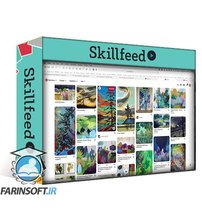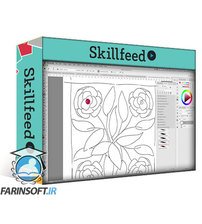در حال حاضر محصولی در سبد خرید شما وجود ندارد.

Are you one of those people who loves pattern? Perhaps you’ve seen some great patterns on wallpaper, or the upholstery on a striking sofa, or a sweet pillow, and you have wondered how it’s done. Maybe you’ve wanted to create a damask, or medallion repeat pattern but have gotten loss in the technical aspects of making it work. Does this sound like you? Scallop repeating patterns can seem very complicated, but like anything, if you break it down and figure out a way to automate parts of the process, you’ll notice that it isn’t too challenging. In my course, Delicious Scallops – Automation to Produce Templates for Pattern Layouts, I’m sharing everything I’ve learned about scallop pattern making from hours of creating and perfecting using my personal technique. This course is specific to the scallop shape with the added bonus of creating a template you can use for hundreds of future repeating pattern designs.
I’ll also show you my step by step process, from planning your scallop to creating the final repeat in Illustrator, to creating the template with transformations, to finally applying the pattern created onto mockups. Don’t worry! It’s not that hard
This class will focus on creating patterns with transformed elements. What I mean by that is you will only need to create the single scallop, and Illustrator will do all the repeat work in a LIVE way. You will see what is happening with your motifs everywhere in the repeat as you do the initial scallop. I would recommend some knowledge of pattern-making with the goal of wanting to learn additional techniques. In class, we’ll talk about both design and technical aspects of reflected repeats. We’ll discuss design theory which enhances and reinforces the scallop shape. I will demonstrate the Illustrator software engines which include transformation and live transformation. I will be demonstrating using Illustrator, but it’s the concepts that are important, and these could easily be applied in similar software as well.
For class, you will need a way to create your motifs, so a draw program (vector based) is recommended. Examples include Affinity Designer and Corel DRAW. You will need to be able to create or import your vector drawn motifs, copy them, reflect them, and move them. Although some of the steps seem quite advanced, I will demonstrate them at a reasonable pace so that it will be easy to follow along. This course is not really for beginner levels; I recommend being acquainted with Illustrator somewhat, and, also knowing the basic principles of creating pattern repeats.
Adobe Illustrator is recommended for this class, so as that is what is being featured here, and it makes use of the Transformation Effects and the Appearance Panel.
The key concepts I will include:
This is a great course for you to take no matter what your purpose for the pattern you create. Start now, so you can be benefitting from your knowledge immediately in your art practice!
Are you primed to create intricate scallop designs and a re-usable template? That’s completely achievable once you have completed this course with me today! Let’s not waste any more time yakking! Let’s get right to it!
Intro:
This short intro will give you an overview of the class.
Lesson 1: Template and Document Set-up
In this lesson, I will show you my inspiration, the initial set up of the scallop shape, and an explanation of the live transformations we will be setting up. I show you the complete pattern collection for which I am making this coordinate, and I explain what my process will be.
Lesson 2: Transformation Settings for Auto Repeat
In this lesson, we will examine methods to help automate the process of designing the repetition in our pattern tile. We will create the “reflect” transformation first, then work towards the “move” transformation which helps repeat our scallop in its 5 different positions to fill our swatch area. This method will allow you to see changes in “real-time”. It’s an amazing way to help you create symmetry and good design.
Lesson 3: Finalizing and Testing the Transformation
In this lesson, we will begin to test our transformation and I will explain important concepts. This lesson is filled with helpful tips and tricks.
Lesson 4: Using the Template to Arrange Motifs
Within this lesson, we will work on arranging the motifs in a pleasing way. I discuss many tips and tricks and you will learn much of the theory around pattern design. Specifically, we look at design considerations to help reinforce the scallop shape.
Lesson 5: Layout Finessing
At this stage of the game, we start to pull our pattern together and ready ourselves for the next step which is finalizing the scallop and repeating the central non-symmetrical elements. We are getting closer and closer to testing our repeat!
Lesson 6: Finalizing the Scallop
This is the last step before we move to testing our repeat! We will experiment with finessing, using techniques such as the envelope warp. We will also talk about color choices and other design considerations.
Lesson 7: Testing Different Color Combos
In this lesson, we will repeat the central elements and will prepare to finalize our color choices. We will experiment with different combos and discuss the implications of using a scallop shape in the background or eliminating it altogether! You will also learn about Illustrator actions which are useful in this type of pattern design.
Lesson 8: Showing Off Our Patterns
Exporting our assets with our final color choices is demonstrated in 2 ways. We first create large samples of our different color swatches and use the asset export panel to export as high resolution files for our mockups. Secondly, we create individual swatches of each color option, open these in Photoshop, and then save them as Photoshop Patterns. We can then choose between using the original exported swatch assets or creating fill layers with each pattern swatch and play with the scale right there in Photoshop. We complete a couple of mockups at this time, one where we create a group with a mask, and one where we use a Smart Object.
Outro
We will conclude everything in this lesson with a chat about next steps.
Concepts covered:
Concepts covered include but are not limited to pattern design, repeated patterns, surface pattern design, damask, scallop pattern, scallop, Illustrator repeat, Illustrator pattern design tool, Illustrator Automation, Illustrator color settings, Illustrator actions, achieving symmetry in design, Illustrator Effects, Illustrator transformation, envelope warp, the Appearance Panel, automated repeats, arranging motifs, color considerations, design considerations, using Illustrator brushes, layout finessing, color experimentation in Illustrator vector pattern design
You will get the bonus of…
در این روش نیاز به افزودن محصول به سبد خرید و تکمیل اطلاعات نیست و شما پس از وارد کردن ایمیل خود و طی کردن مراحل پرداخت لینک های دریافت محصولات را در ایمیل خود دریافت خواهید کرد.


طراحی گل های زیبا و ساده بوسیله Affinity Designer

آموزش ساخت یک محیط و منظره طبیعی در Procreate

Enhanced Stylized Line Art for Pattern Design in Adobe Illustrator Using the Offset Filter

Simple Fast Folk Art Inspired Half Drop Toss Pattern Using Filters, Transformations, & Pattern Maker

آموزش طراحی روسری در نرم افزار Adobe Photoshop

Seamless Half Drop Repeat and Exploring Colorway Options Using Pattern Preview in Photoshop 2021

آموزش استفاده از فتوشاپ برای نقاشی کردن الگوهای تکرار شونده

تصویرگری و نقاشی دیجیتال الگوهای موزاییکی در نرم افزار Procreate

Sparkly 3D Lettering in Procreate with Supplied Brushes and Bonus Procreate Mockup

Vector Brush Gorgeous Line Art Floral Repeat Pattern
✨ تا ۷۰% تخفیف با شارژ کیف پول 🎁
مشاهده پلن ها